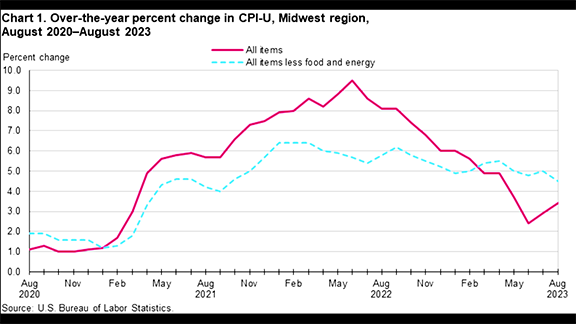KANSAS CITY, Kans. – Prices in the Midwest Region, as measured by the Consumer Price Index for All Urban Consumers (CPI-U), advanced 0.2% in August, the U.S. Bureau of Labor Statistics reported today. The energy index advanced 3.4% in August, with the index for gasoline driving almost all of the rise. The index for all items less food and energy and the index for food partially offset the rise in the two-month all items index, with both declining 0.1% over the same period.
Over the last 12 months, the CPI-U rose 3.4%. The index for all items less food and energy rose 4.5% over the year, while the index for food increased 3.9%. Partially offsetting the increase, the index for energy declined 6.6%, largely the result of a decrease in prices paid for natural gas service. (See chart 1.)

Food
Food prices declined 0.1 percent for the month of August. Prices for food at home (grocery store prices) decreased 0.2 percent, and prices for food away from home (restaurant, cafeteria, and vending purchases) increased 0.2 percent over the same period. Within the food at home category, the index for nonalcoholic beverages and beverage materials (-1.5 percent) contributed the most to the over-the-month decline. The decrease in food at home prices was somewhat offset by a decline in prices paid for other food at home (which includes sugars, sweets, fats, and oils), which rose 0.5 percent.
Over the year, food prices increased 3.9 percent. Prices for food away from home advanced 5.8 percent, and prices for food at home rose 2.8 percent over the same period. Within the food at home category, prices paid for other food at home (+4.8 percent) and cereals and bakery products (+5.7 percent) contributed the most to the rise.
Energy
The energy index advanced 3.4 percent over the month. The increase was almost entirely due to higher prices for gasoline (+6.7 percent). Partially offsetting the increase was a decline in prices paid for natural gas service (-0.5 percent) and electricity (-0.1 percent).
Energy prices declined 6.6 percent over the year. A decrease in the index for natural gas service (-28.6 percent) contributed the most to the decline. Prices for gasoline also contributed to the decrease in the index, falling 3.4 percent over the year. An increase in the index for electricity (+3.3 percent) slightly offset the decline.
All items less food and energy
The index for all items less food and energy fell 0.1 percent in August, led by declines in the indexes for lodging away from home, used cars and trucks (-1.7 percent), and recreation (-0.5 percent). The largest index increasing contributors included owners’ equivalent rent of residences (+0.4 percent), medical care (+1.0 percent), and apparel (+2.0 percent), which largely offset the declines.
Over the year, the index for all items less food and energy rose 4.5 percent. Components contributing most to the increase included owners’ equivalent rent of residences (+6.9 percent), rent of primary residences (+7.0 percent), and recreation (+4.3 percent). Partly offsetting these increases were falling prices for used cars and trucks (-6.4 percent) and public transportation.
